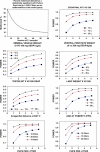Fifteen years after "Wingspread"--environmental endocrine disrupters and human and wildlife health: where we are today and where we need to go
- PMID: 18281716
- PMCID: PMC2721670
- DOI: 10.1093/toxsci/kfn030
Fifteen years after "Wingspread"--environmental endocrine disrupters and human and wildlife health: where we are today and where we need to go
Abstract
In 1991, a group of expert scientists at a Wingspread work session on endocrine-disrupting chemicals (EDCs) concluded that "Many compounds introduced into the environment by human activity are capable of disrupting the endocrine system of animals, including fish, wildlife, and humans. Endocrine disruption can be profound because of the crucial role hormones play in controlling development." Since that time, there have been numerous documented examples of adverse effects of EDCs in invertebrates, fish, wildlife, domestic animals, and humans. Hormonal systems can be disrupted by numerous different anthropogenic chemicals including antiandrogens, androgens, estrogens, AhR agonists, inhibitors of steroid hormone synthesis, antithyroid substances, and retinoid agonists. In addition, pathways and targets for endocrine disruption extend beyond the traditional estrogen/androgen/thyroid receptor-mediated reproductive and developmental systems. For example, scientists have expressed concern about the potential role of EDCs in increasing trends in early puberty in girls, obesity and type II diabetes in the United States and other populations. New concerns include complex endocrine alterations induced by mixtures of chemicals, an issue broadened due to the growing awareness that EDCs present in the environment include a variety of potent human and veterinary pharmaceutical products, personal care products, nutraceuticals and phytosterols. In this review we (1) address what have we learned about the effects of EDCs on fish, wildlife, and human health, (2) discuss representative animal studies on (anti)androgens, estrogens and 2,3,7,8-tetrachlorodibenzo-p-dioxin-like chemicals, and (3) evaluate regulatory proposals being considered for screening and testing these chemicals.
Figures


References
-
- Adams NR. Organizational and activational effects of phytoestrogens on the reproductive tract of the ewe. Proc. Soc. Exp. Biol. Med. Soc. Exp. Biol. Med. 1995;208:87–91. - PubMed
-
- Ames BN, Gold LS. Paracelsus to parascience: the environmental cancer distraction. Mutation research. 2000;447:3–13. - PubMed
-
- Ankley GT, Brooks BW, Huggett DB, Sumpter JP. Repeating History: pharmaceuticals in the environment. Environ. Sci. Technol. 2007;41:8211–8217. - PubMed
-
- Ankley G, Mihaich E, Stahl R, Tillitt D, Colborn T, McMaster S, Miller R, Bantle J, Campbell P, Denslow N, et al. Overview of a workshop on screening methods for detecting potential [anti-] estrogenic/androgenic chemicals in wildlife. Environ. Toxicol. Chem. 1998;17:68–87.
-
- Ankley GT, Giesy JP. Pensacola: SETAC Press; 1998. Endocrine Disruptors in Wildlife: A Weight of Evidence Perspective.

